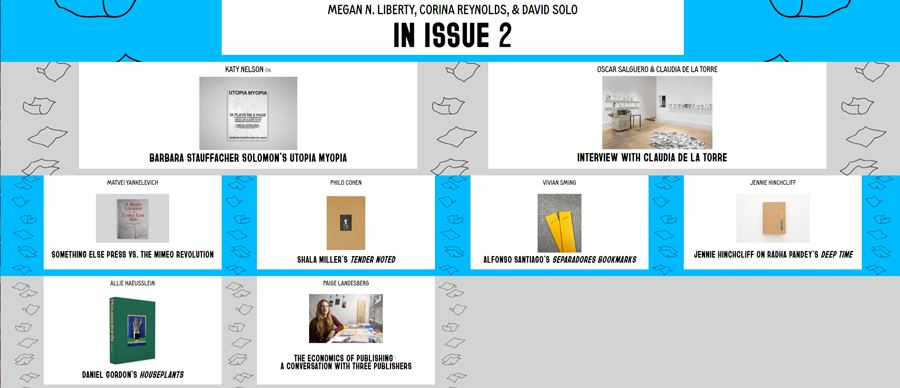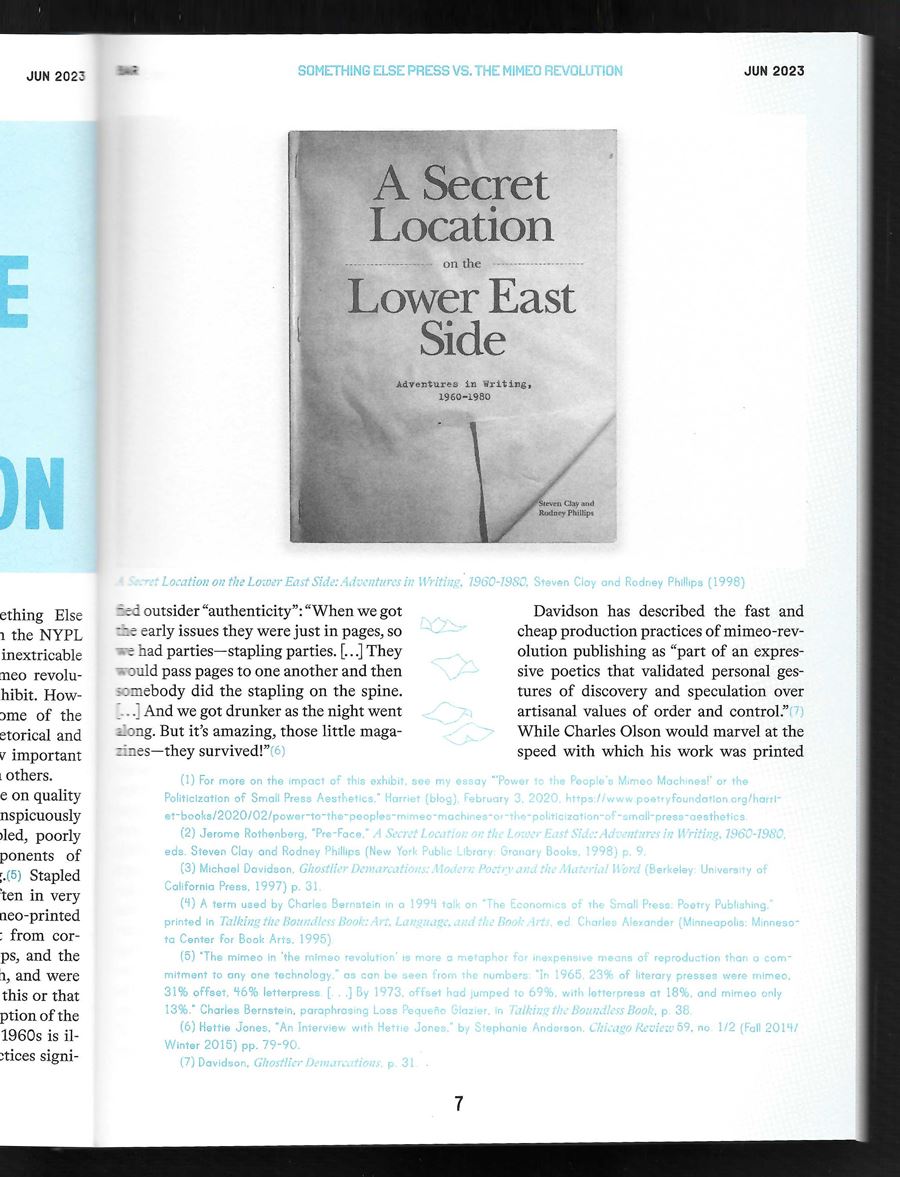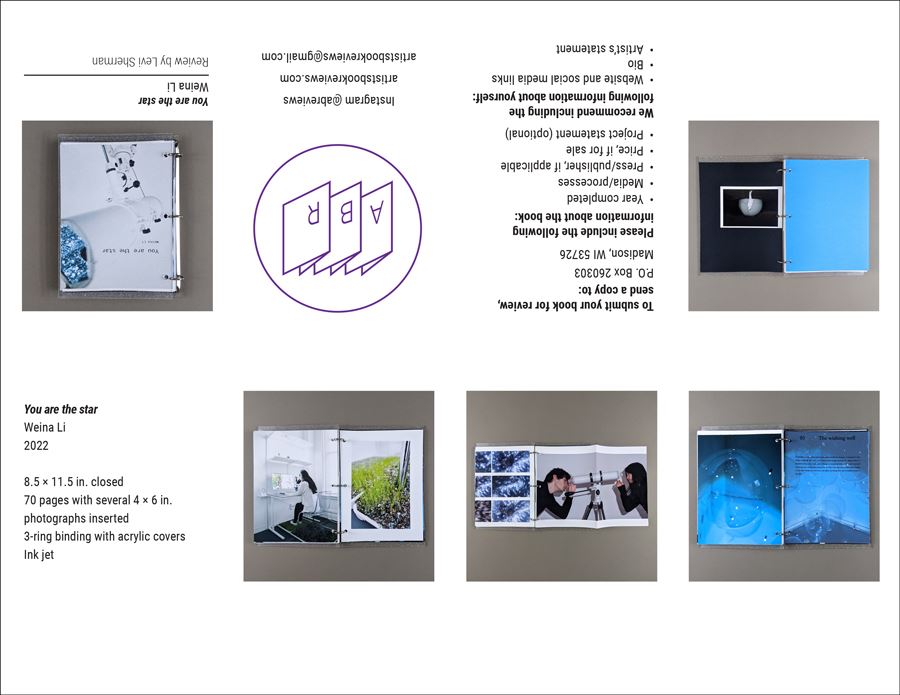In July of 2023, Levi Sherman and David Solo sat down over Zoom to talk about some of their goals and issues they’ve encountered in running platforms for artist book criticism and reviews. This is Part 2 of that conversation. Read Part 1 here.


Book Art Review online contents for issues 1 and 2.
What observations about the nature of artist books arise from running these platforms?
LS: In the 1960s and ‘70s, people like Dick Higgins and Ulises Carrión saw artist books as a vehicle for revitalizing literature (and art). Now the field has matured to the point that an artist can set out to make an artist book, to contribute to this tradition without challenging or galvanizing literature or art more broadly. Good or bad, this seems like a fundamental difference. It brings us back to the issue of artist intent.
With the maturity of the field, two conflicting tenets have emerged. On one hand, “production, not reproduction” means the critic should consider every aspect of how a book was made. Artists often facilitate this with extensive paratext. On the other hand, there is a belief that the artist book itself should tell the reader how it should be read. If the work succeeds, readers will handle an unfamiliar structure or read through challenging content. I don’t think these are mutually exclusive, and critics can evaluate how artists navigate the tension. For example, if a book is destined for an institutional collection, the artist can rely on more paratext than an activist anonymously distributing pamphlets.

BAR Issue 2 article on Something Else Press.
DS: Another facet of books going into institutional (or private) collections is the potential for those books to disappear and complicate the desire to view and study them. A related challenge working with institutions involves balancing their mission to preserve/conserve books and the desire for visitors to experience the book as it was intended and handle it. While setting up reading rooms or events for live engagement with books can be great for expanding visibility, many organizations are reluctant or not able to do so unless they have “disposable” duplicate copies.
LS: Many libraries do a great job selecting and showing books, but how much time is spent really reading? Imagine taking a film class where you only watched the trailers, or fast-forwarded every film? That seems analogous to a lot of institutional artist book encounters. I’d like to see more artist books on coffee tables and nightstands, and for artists to consider how the reading environment informs pace and duration.
DS: Digitization (including page-turning videos/applications) can provide some help (within the restrictions of copyright and subject to makers’ preferences). A lot of work has been done to make both contemporary and historic photobooks viewable online which seems to affect the way they’re written about. Critics, publishers and artists have all contributed to this which perhaps also reflects the photobook as a major means of getting the photographer’s work seen. The large number of prizes and the huge number of annual “top 10” lists for photobooks also contribute to the greater visibility of such works. It’s also interesting to think about how that might translate to the wider artists’ book world.
LS: For artist books, digitization is stymied by two factors. First, book artists are more invested in materiality and hapticality than many photographers, so digital surrogates don’t seem adequate (although I personally think the benefits outweigh the shortcomings). Second, collection managers are very wary of copyright. So much of the art librarianship literature about artist books is about copyright, but I rarely hear book artists worry about a collection photographing their work. Digital access seems especially important since the artist book field doesn’t have many awards and prizes or other platforms. More prizes and events might be good, but a silver lining is that the pace of criticism can be slower and less oriented toward marketing.

One side of the printable mini-zine version of a review from Artists’ Book Reviews (ABR). Each review is limited to five photographs to respect copyright and fit various formats, from full-length print and online reviews to abbreviated Instagram versions.
How does criticism relate to the idea of a canon?
DS: I’m less interested in revisiting the canon or creating multiple canons than in expanding the discussion of books that are interesting (in a variety of ways and to different audiences). It’s OK if these are mostly individual opinions (as are prizes). We want to recognize that and promote more discussion of what someone thinks is a great book and why — especially for overlooked or underrepresented areas. Shining a light on overlooked histories of the artist book (or photobook) is rewarding as we’ve also been working to do with 10×10 photobooks. It’s more about exposing those works rather than trying to then interpolate them into a new “top 100”. More useful is “Here’s a lot of great books that most of you have never seen.” Anointing a list as “the right answer” feels dangerous for any list.
LS: I don’t think criticism should try to build or revise a canon, but if we ignore whatever artist book canon already exists, we may use it unwittingly as a benchmark. We should examine how our values reflect works that have been institutionalized and consider what those values exclude.
As an art historian, I am interested in (re)inserting artist books into mainstream art history. That doesn’t mean adding books to the art historical canon, though — in fact, artist books might be a good vehicle for deconstructing the boundaries between center and periphery. Through my own research into artist book historiography, I’ve learned how contingent the canon is (except, of course, the influences of structural racism, and sexism, etc., which are sadly predictable). Other research, including Megan N. Liberty’s institutional history reveals how the field has formed. I’m not sure whether criticism can contribute to this, but knowing the history will help critics avoid pitfalls.
Levi is the founder and editor of Artists’ Book Reviews (https://artistsbookreviews.com/), a website for reviews and interviews. David is a co-founder and co-editor of Book Art Review (BAR), a criticism initiative founded at Center for Book Arts in 2020 by Megan N. Liberty, Corina Reynolds, and David Solo. BAR is both a print and online (at https://centerforbookarts.org/bar ) publication.

